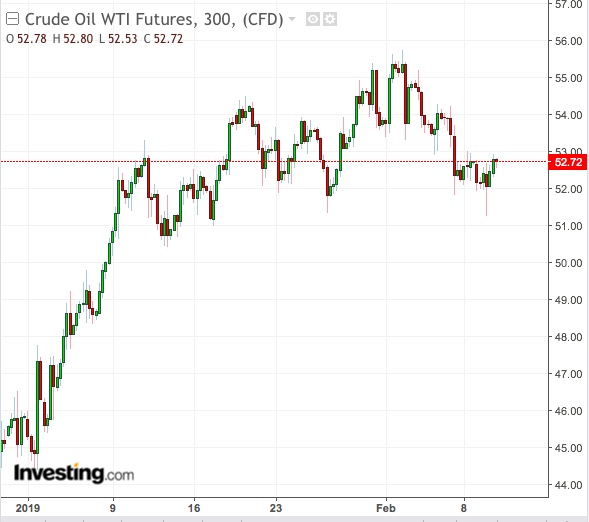Oil bulls made a ponderous run into 2019—and are finding it increasingly hard to keep their pace.
Few hurdles appeared in crude’s upward path when the year began as relentless Saudi production cuts since December kept up a powerful rally that began just after Christmas. Recent U.S. sanctions on Venezuelan oil also projected the vision of a market that could be so tight by mid-year that finding spare capacity might be extremely difficult, if not next to impossible.

Yet after posting a 19 percent gain that would make for a record January return and piercing the $55 per barrel ceiling last broken in November, the outlook for New York-traded West Texas Intermediate crude has suddenly turned dire.
Refinery Outages, Overproduction Threats
Outages in recent days at major refineries are causing WTI supplies to swell at the key Cushing, Oklahoma storage hub for U.S. crude, potentially setting the market up for downbeat data in the coming week or two if not resolved quickly.
If that’s not enough, overproduction could be looming again among U.S. oil producers, finding prices north of $50 per barrel lucrative enough to finish drilled-but-uncompleted wells.
On the global front, worries of an economic slowdown are taking on a stronger conviction across the world, from Europe to Asia, making it hard for Brent, the world's oil benchmark, to hold on to any run above $62 a barrel.
Scott Shelton, energy futures broker for ICAP in Durham, North Carolina, said in a note on Monday that the flat price of oil is “a non-event for me overall as we remain in a range with a lot of noise.”
Shelton said his bias for WTI was low as the market failed to accelerate on its last rally above $55.
Inadequate Fundamental Support
He added:
“This tells me that producer selling is too heavy on rallies and there isn’t enough fundamental support to bring in real oil buying.”
WTI lost almost 5 percent last week, for its steepest weekly decline since the year began.
And its outlook worsened this week after the second largest crude distillation unit (CDU) at Phillips 66 (NYSE:PSX)'s Wood River refinery, which runs 330,000 barrels per day, remained closed from a weekend fire.
Phillips 66 also reported another unit closure at its 76,000-bpd refinery in Ponca City, Oklahoma, which processes crude flows from Cushing, the storage hub for WTI.
Cushing stockpiles rose to 42.6 million barrels in the week to Feb. 1, the highest level since early January 2018, the U.S. Energy Information Administration said.
Expectations of supply increases at the storage hub pushed the discount for WTI versus Brent to the widest level in nearly two months, at $9.52 a barrel, Reuters data showed.
Weighing further on WTI were worries on what Friday's weekly rig count data could show, after last week’s rise of 7 units after the previous week's drop of 15.
Perfect Storm
Shelton summed up:
"It’s a perfect storm of bearish information for WTI … as fears of tank tops will only worsen for Q2 on this information.”
WTI still remains nearly 25 percent higher than the Christmas Eve low of $42.36 struck during last year’s devastating selloff in oil.
But it has been trapped in a $51-$54 range, unable to make new highs since last week’s November peaks of $55.75.
Investing.com has a “Sell” call for the U.S. crude benchmark on its daily technical outlook, with the lowest technical support pegged just under $50 per barrel, at $49.95.
For Brent, the technical call is still a “Buy”, although support at the lows is just under $60 per barrel at $59.38.
The outlook on Brent soured after the European Union last week slashed its forecast for economic growth in the 19-nation euro bloc.
Choppy, Volatile Trade Ahead
Meanwhile, the stalemate in the Venezuelan leadership crisis and U.S.-China trade war is beginning to wear down the patience of some middling supporters of oil.
U.S. President Donald Trump said he would not meet his China counterpart Xi Jinping before the month is out, missing an opportunity to hold a summit that might have expedited a trade deal between the two countries. Treasury Secretary Steven Mnuchin and Trade Representative Robert Lighthizer are, however, in Beijing this week for another round of talks.
China needs a trade deal with the U.S. by March 1 or risks having Trump raise tariffs on $200 billion of Chinese goods to 25 percent from 10 percent. China is also the world’s largest crude importer, making its economic health all the more important for the oil market.
Said Dominick Chirichella, director of risk in oil trading at the DTN-owned Energy Management Institute in New York:
“The market remains uncertain as to the state of the global economy and what the outcome will be of the latest round of trade negotiations taking place in China.”
“For the short term, the market is going to remain in a choppy, volatile trading pattern as too much uncertainty is clouding the market and preventing the trading community from entering any medium-term trading positions.”
